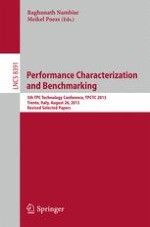2014 | Buch
Performance Characterization and Benchmarking
5th TPC Technology Conference, TPCTC 2013, Trento, Italy, August 26, 2013, Revised Selected Papers
herausgegeben von: Raghunath Nambiar, Meikel Poess
Verlag: Springer International Publishing
Buchreihe : Lecture Notes in Computer Science
